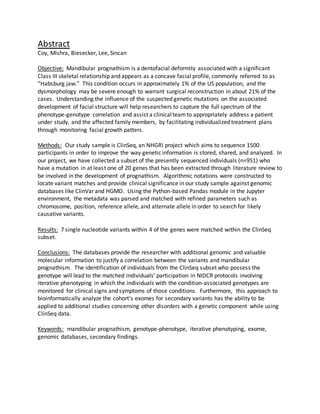
Mandibular prognathism genetic study using ClinSeq data
- 1. Abstract Coy, Mishra, Biesecker, Lee, Sincan Objective: Mandibular prognathism is a dentofacial deformity associated with a significant Class III skeletal relationship and appears as a concave facial profile, commonly referred to as “Habsburg jaw.” This condition occurs in approximately 1% of the US population, and the dysmorphology may be severe enough to warrant surgical reconstruction in about 21% of the cases. Understanding the influence of the suspected genetic mutations on the associated development of facial structure will help researchers to capture the full spectrum of the phenotype-genotype correlation and assist a clinicalteamto appropriately address a patient under study, and the affected family members, by facilitating individualized treatment plans through monitoring facial growth patters. Methods: Our study sample is ClinSeq, an NHGRI project which aims to sequence 1500 participants in order to improve the way genetic information is stored, shared, and analyzed. In our project, we have collected a subset of the presently sequenced individuals (n=951) who have a mutation in at least one of 20 genes that has been extracted through literature review to be involved in the development of prognathism. Algorithmic notations were constructed to locate variant matches and provide clinical significance in our study sample against genomic databases like ClinVar and HGMD. Using the Python-based Pandas module in the Jupyter environment, the metadata was parsed and matched with refined parameters such as chromosome, position, reference allele, and alternate allele in order to search for likely causative variants. Results: 7 single nucleotide variants within 4 of the genes were matched within the ClinSeq subset. Conclusions: The databases provide the researcher with additional genomic and valuable molecular information to justify a correlation between the variants and mandibular prognathism. The identification of individuals from the ClinSeq subset who possess the genotype will lead to the matched individuals’ participation in NIDCR protocols involving iterative phenotyping in which the individuals with the condition-associated genotypes are monitored for clinical signs and symptoms of those conditions. Furthermore, this approach to bioinformatically analyze the cohort’s exomes for secondary variants has the ability to be applied to additional studies concerning other disorders with a genetic component while using ClinSeq data. Keywords: mandibular prognathism, genotype-phenotype, iterative phenotyping, exome, genomic databases, secondary findings.